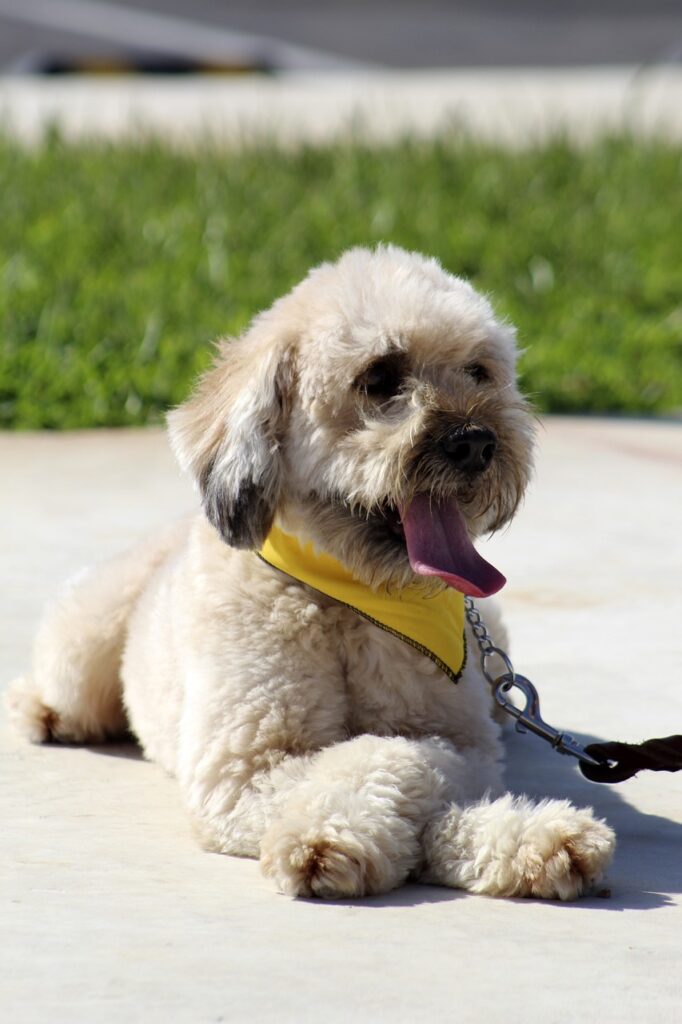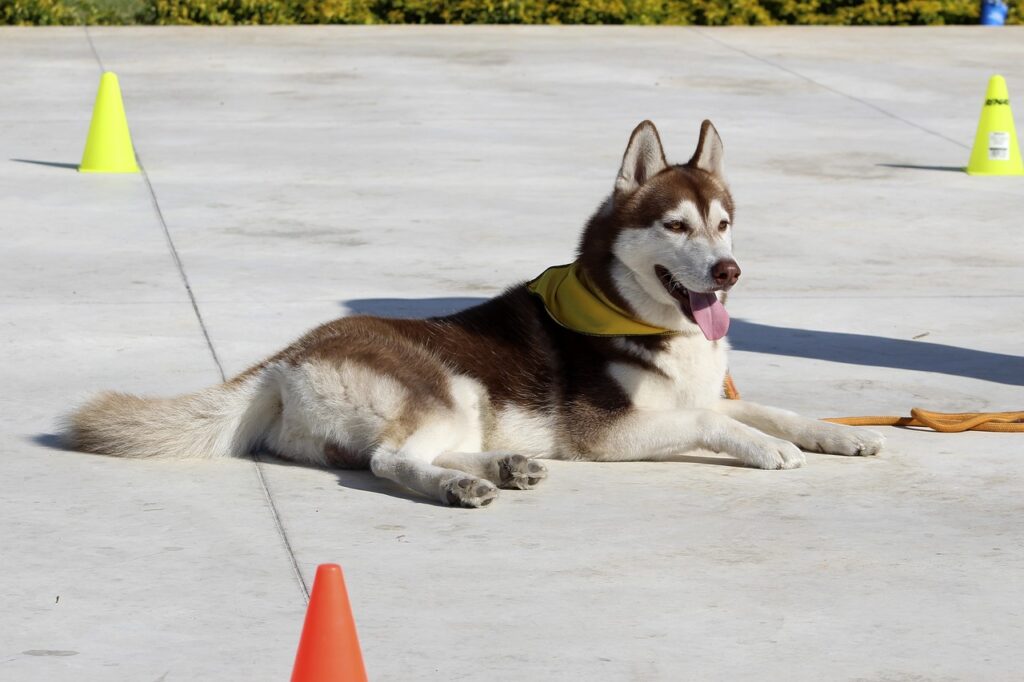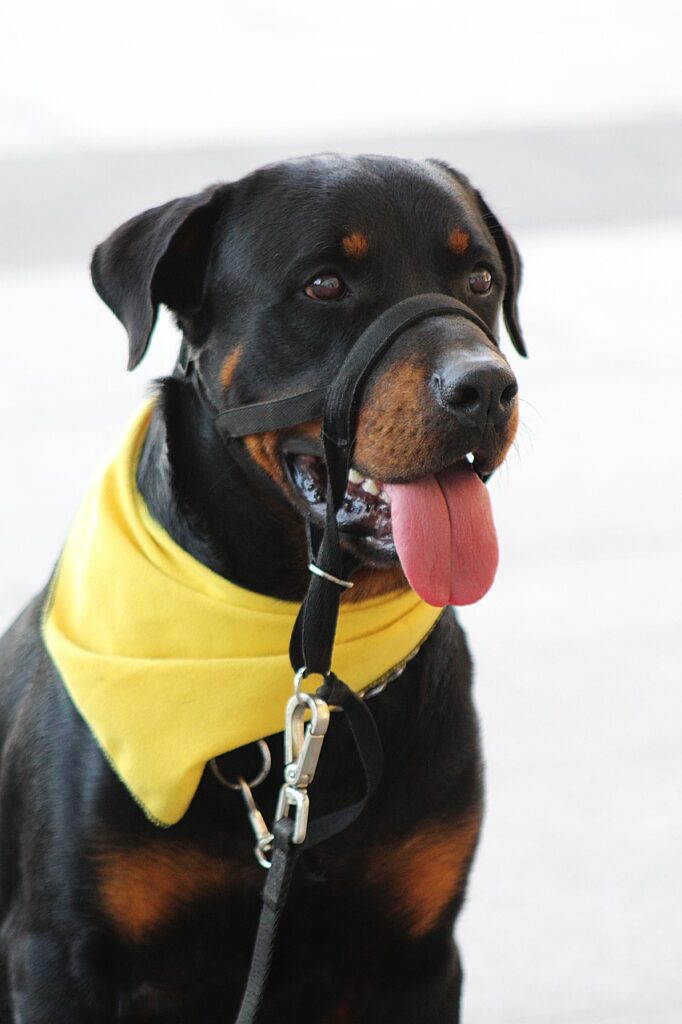
So you’ve just brought home a new furry friend and you can’t wait to start teaching them some basic obedience commands. One of the first commands you’ll want to tackle is “sit and stay,” as it sets the foundation for many other behaviors. Teaching your dog to sit and stay not only helps with behavior management but also promotes a strong bond between you and your four-legged companion. In this article, we’ll explore some simple yet effective techniques to help you train your dog to sit and stay with ease. You’ll soon be amazed at how quickly your pup learns these commands and how much more enjoyable your daily interactions will become.

This image is property of pixabay.com.
Understanding the importance of sit and stay commands
Sit and stay as fundamental commands
The sit and stay commands are fundamental skills that every dog should learn. These commands not only help with controlling your dog in various situations but also promote safety, good behavior, and effective communication between you and your furry companion.
The “sit” command teaches your dog to sit down on their haunches, while the “stay” command instructs them to remain in that position until you release them. These commands are valuable tools in everyday life, whether you’re at home, in public places, or interacting with other dogs and people.
Benefits of teaching sit and stay
Training your dog to sit and stay offers numerous benefits. Firstly, it establishes you as the leader of the pack, reinforcing that you are in control and your dog should listen to your commands. This helps build a strong bond between you and your pet, enhancing your relationship.
Moreover, the sit and stay commands enhance your dog’s self-control and impulse management. By teaching them to sit and stay, you can prevent them from jumping, running away, or engaging in potentially dangerous behaviors. It also allows you to maintain control in situations where your dog’s excitement or anxiety may escalate.
The sit and stay commands also come in handy during vet visits, grooming sessions, and when guests visit your home. With proper training, you can ensure your dog remains calm, making these experiences more pleasant and stress-free for both of you.
Preparing for training sessions
Creating a suitable training environment
Before starting your training sessions, it’s important to create a suitable environment for optimal learning. Choose a quiet area free from distractions where you and your dog can focus on the training. This could be a room in your home or a secure outdoor space.
Remove any objects that might divert your dog’s attention and cause them to lose focus. Clear the training area of toys, food bowls, or anything that may compete for your dog’s attention during the training session.
Gathering necessary tools and treats
To effectively train your dog to sit and stay, you’ll need a few essential tools. Firstly, have a sturdy, comfortable leash and collar or harness that fits your dog properly. Ensure the leash is long enough to allow your dog some freedom of movement but still enables you to maintain control.
Treats are a powerful motivator during training. Choose small, soft, and easily consumable treats that your dog loves. These treats will serve as rewards for good behavior and will help reinforce the desired command. Have a supply of treats readily available during the training session.
Teaching the sit command
Introducing the sit command
To start teaching the sit command, hold a treat close to your dog’s nose and slowly move it upwards above their head. As your dog follows the treat’s movement, their bottom should naturally lower into a sitting position. As soon as they sit, say “sit” in a clear and upbeat tone and immediately reward them with the treat.
Repeat this process several times, gradually introducing the verbal cue “sit” before moving the treat. Over time, your dog will associate the word “sit” with the action of sitting down. Practice this command in short, frequent sessions throughout the day to reinforce the behavior.
Using treats and rewards
Throughout the training process, treats and rewards play a vital role in motivating your dog to sit. Every time your dog successfully sits upon command, reward them with a treat and praise them. Positive reinforcement encourages your dog to repeat the desired behavior and strengthens their understanding of the command.
It’s important to use a consistent and positive tone of voice when giving commands and providing rewards. Dogs respond best to praise and encouragement, so be sure to shower them with affection and verbal praise when they perform the command correctly.
Repetition and consistency
Consistency is key when teaching the sit command. Repeat the training sessions regularly to reinforce the behavior and ensure your dog retains the information. Consistent repetition helps them understand that sitting is expected whenever the command is given.
Keep the training sessions short and enjoyable, as dogs have short attention spans. Aim for multiple brief training sessions throughout the day, rather than one lengthy session. Incorporate the sit command into your daily routines, such as before mealtime or going for a walk, to reinforce the behavior consistently.
Improving the sit command
Adding verbal cues
Once your dog has mastered the sit command, you can begin to add verbal cues to enhance their understanding and responsiveness. Begin by giving the verbal cue “sit” without using any hand signals or treats. If your dog responds correctly, promptly reward them with praise and a treat.
Gradually reduce the reliance on treats by rewarding your dog intermittently but continue to praise and reinforce their behavior with verbal cues. Repeating this process consistently will reinforce the association between the verbal command and the desired action, allowing your dog to respond reliably even without the presence of treats.
Using hand signals
In addition to verbal cues, using hand signals can further enhance your dog’s understanding and response to the sit command. Start by using a simple and clear hand signal, such as raising your hand with an open palm in front of your dog’s face.
While giving the verbal command “sit,” simultaneously raise your hand with the hand signal. As your dog sits, reward them with praise and a treat. Gradually, your dog will begin to associate the hand signal with the command, allowing you to give signals without verbal cues in the future.
Gradually reducing treats
To ensure long-term success, it’s important to gradually reduce the reliance on treats when practicing the sit command. Once your dog consistently responds to the verbal and hand signals, begin to reward them with treats intermittently rather than every time they sit.
Instead of treating after every sit, randomly reward your dog with treats during some training sessions. This unpredictable reward system keeps your dog engaged and reinforces the behavior without creating dependency on treats. Remember to always praise and provide verbal reinforcement, even when treats are not given.

This image is property of pixabay.com.
Teaching the stay command
Building a foundation with sit
Before teaching the stay command, ensure your dog has a solid understanding of the sit command. The sit command will serve as the foundation for the stay command. Begin by giving the sit command, ensuring your dog remains seated.
Once your dog is in the sitting position, extend your arm, palm facing your dog, and say “stay” in a clear, firm tone. Maintain eye contact with your dog and take a step backward. If your dog remains in the sitting position without moving towards you, reward them with praise and a treat.
Teaching the release command
After your dog has learned to stay in the sitting position, it’s important to teach them a release command. This command will indicate when it’s appropriate for your dog to move from the stay position.
To introduce the release command, use a specific word or phrase such as “okay” or “free.” Say the release command in an enthusiastic, joyful tone and encourage your dog to come towards you or engage in another activity. Providing positive reinforcement with praise or treats when your dog follows the release command will solidify their understanding of the cue.
Implementing distance and duration
As your dog becomes more proficient in staying, you can gradually increase the distance between you and your dog. Start by moving a few steps backward, then gradually increase the distance over several training sessions.
Similarly, increase the duration of the stay command. Begin by requiring your dog to stay for a few seconds, gradually building up to several minutes. Remember to reward your dog with praise and treats for successfully maintaining the stay position.
Advancing the stay command
Introducing distractions
Once your dog has a reliable understanding of the stay command in a controlled environment, it’s time to introduce distractions. Start with mild distractions, such as a low-level noise or a toy being rolled nearby. If your dog remains in the stay position, reward them with praise and a treat.
Gradually increase the level of distractions, incorporating more challenging elements such as other dogs, people walking by, or enticing smells. This will help your dog learn to maintain focus and stay in the desired position regardless of distractions.
Practicing in different environments
To ensure your dog understands the stay command in various situations, practice in different environments. Begin by practicing in your home or backyard, then progress to public places with controlled distractions, such as busy parks or shopping areas.
Repetition in different environments will help your dog generalize the stay command, allowing them to respond reliably regardless of the surroundings. It’s crucial to maintain consistency in your commands and reward systems to ensure your dog understands the expectations no matter where they are.
Increasing distance and duration
Continue to challenge your dog by gradually increasing the distance and duration of the stay command. Move farther away from your dog while maintaining eye contact and giving the stay command. As they successfully hold the stay position, reward them with praise and treats.
Similarly, extend the duration of the stay command. Start with short intervals and gradually build up to several minutes. Be patient and increase the difficulty gradually, ensuring your dog remains engaged and successful throughout the process.

This image is property of pixabay.com.
Common challenges during training
Impatience and frustration
Training your dog can sometimes be challenging, especially when they don’t respond as quickly as anticipated. It’s important to remain patient and avoid getting frustrated. Dogs can sense your emotions, and if they feel your frustration, it may hinder their willingness to learn.
Remember that every dog learns at their own pace. Celebrate small victories and progress, no matter how incremental. Consistency, repetition, and positive reinforcement are key in overcoming challenges and reaching your training goals.
Lack of consistency
Consistency is vital when training your dog. Inconsistencies in commands, rewards, or expectations can confuse your dog and hinder their progress. Ensure that all family members who interact with the dog are using the same commands and reward systems to avoid confusion.
Establishing a consistent routine and schedule for training sessions will also help your dog understand when to expect training and be more receptive to learning. Consistency provides a clear framework for your dog, making it easier for them to understand and comply with your commands.
Understanding individual dog’s abilities
Every dog is unique, and their learning abilities may vary. Some dogs may grasp the sit and stay commands quickly, while others may require more time and repetition. It’s important to recognize and understand the individual abilities and limitations of your dog.
Tailor your training approach to suit your dog’s personality, energy levels, and learning style. Be patient and adapt your methods as needed to ensure that your dog remains engaged and motivated throughout the training process.
Overcoming training obstacles
Re-evaluating training techniques
If you encounter challenges or obstacles during the training process, it may be necessary to re-evaluate your training techniques. Consider whether the methods you’re using are appropriate for your dog’s temperament and learning style.
Experiment with different training approaches, such as clicker training or shaping, to find the method that resonates best with your dog. Every dog is unique, and what works for one may not work for another. Be open to trying new techniques and seek guidance from professional trainers or behaviorists if needed.
Breaking down commands into smaller steps
Breaking down commands into smaller, achievable steps can help overcome training obstacles. If your dog is struggling with the sit or stay command, analyze the specific component they find challenging.
For example, if your dog has difficulty with the stay command, focus on teaching them to stay for shorter durations before gradually increasing the time. Breaking the command into smaller steps allows your dog to build confidence and gradually progress towards the desired behavior.
Seeking professional help if needed
If you’re facing persistent challenges or feel overwhelmed by the training process, it may be beneficial to seek professional help. Professional dog trainers or behaviorists have the knowledge and expertise to assess your dog’s specific needs and develop a tailored training plan.
They can offer guidance, hands-on training, and valuable insights into your dog’s behavior. Seeking professional help is not a sign of failure but rather a proactive step in ensuring your dog receives the best training and support possible.
Maintaining consistency and reinforcement
Regular practice to reinforce commands
Consistency is essential in maintaining your dog’s training progress. Schedule regular training sessions to reinforce the sit and stay commands. Short, frequent sessions are more effective than sporadic, lengthy sessions.
Incorporate training into your daily routines, tying it in with activities such as feeding times, walks, or playtime. Consistent practice will reinforce the commands, preventing regression and ensuring that your dog retains and follows the learned behaviors.
Using positive reinforcement techniques
Positive reinforcement is a powerful tool when it comes to maintaining your dog’s training. Continue to reward your dog with praise, affection, and occasional treats whenever they successfully execute the sit and stay commands.
Positive reinforcement not only reinforces the desired behavior but also builds confidence and a positive association with training. Celebrate your dog’s accomplishments, no matter how small, and shower them with love and encouragement to keep them motivated and engaged.
Incorporating sit and stay in daily routines
To solidify the sit and stay commands as part of your dog’s everyday behavior, incorporate them into your daily routines. Use the sit command before mealtimes, when putting on their leash, or before opening the door for a walk.
Similarly, utilize the stay command when you need your dog to remain in a specific area or while you attend to household chores. Consistently incorporating these commands into your daily routines helps reinforce the behaviors and makes them a natural part of your dog’s obedience.
Building on foundational commands
Progressing to other obedience commands
Once your dog has mastered the sit and stay commands, you can progress to teaching them other obedience commands. These commands include “down,” “come,” “heel,” and “leave it,” among others. Each command builds on the foundation of sit and stay, enhancing your dog’s overall obedience and control.
Continue to use the same positive reinforcement techniques and consistency when teaching these commands. Break each command down into smaller steps, gradually increasing the difficulty and incorporating distractions to ensure your dog’s success.
Exploring advanced training skills
Advanced training skills further enhance your dog’s obedience, mental stimulation, and overall behavior. These skills include tricks, agility training, scent work, or even participating in dog sports. These activities provide a constructive outlet for your dog’s energy, strengthen the bond between you and your pet, and can be a fun and rewarding experience for both of you.
Remember to approach advanced training gradually, building on the foundational commands and using positive reinforcement. Make the training sessions enjoyable and rewarding for your dog, and always prioritize their safety and well-being throughout.
Continuing education with your dog
Training your dog is an ongoing process that requires consistent effort and dedication. Just like humans, dogs benefit from continued mental stimulation and education. Keep challenging your dog with new commands, tricks, and activities to keep their minds sharp and their skills sharp.
Participate in training workshops, join training classes, or seek out online resources to expand your knowledge and learn alongside your dog. Continued education and enrichment not only provide mental stimulation for your dog but also deepen your bond and enhance the overall quality of your relationship.
By understanding the importance of sit and stay commands, preparing for training sessions, and following effective techniques, you can successfully train your dog to sit and stay. With patience, consistency, and positive reinforcement, both you and your furry friend will enjoy the benefits of a well-trained and obedient companion in various aspects of your life. So, embark on this training journey with enthusiasm and watch your dog thrive as they master these fundamental commands.

